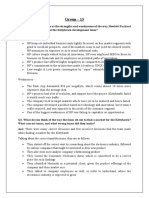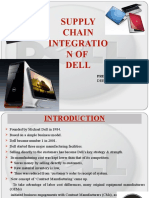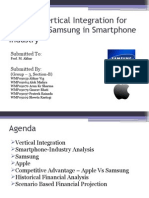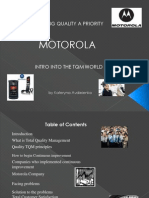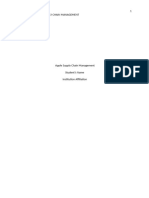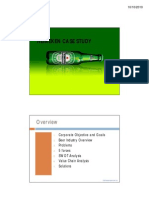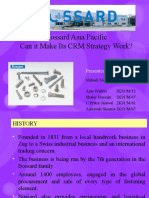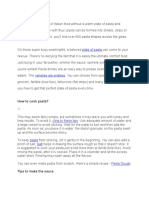Heineken
Heineken
Uploaded by
simaosbCopyright:
Available Formats
Heineken
Heineken
Uploaded by
simaosbOriginal Title
Copyright
Available Formats
Share this document
Did you find this document useful?
Is this content inappropriate?
Copyright:
Available Formats
Heineken
Heineken
Uploaded by
simaosbCopyright:
Available Formats
What Who How
Premium
Global
beer
and
price
Young
adults
presence:
170
countries
Diversified
portfolio
Emphasis
on
Status
Brand
image
reputation
Company Strategic International Comparative Future
Overview Analysis Strategy Analysis Challenges
1864 • Heineken family entered the beer business
1921‐1931 • Moving into US and Asian markets
1949 • Beer can travel – focus on brand & marketing
1961 • Expansion to South America and Africa
1968
• Heineken
merged
with
biggest
competitor
Amstel
• Cooperation
with
Coca‐Cola
in
Brazil
1983
• Entering
the
Japanese
market
under
a
license
2008 • Acquisition of Scottish & Newcastle
2010 • Merger with FEMSA
Company Strategic International Comparative Future
Overview Analysis Strategy Analysis Challenges
Company Strategic International Comparative Future
Overview Analysis Strategy Analysis Challenges
2005 2008
+19% +27%
Volume 125,000 Revenue 4,318
thousand
mil. €
hectolitres
Worldwide Volume (millions of hectoliters) Worldwide Revenue (€ million)
300 17000
200 16000
Heineken Heineken
15000
100 Inbev Inbev
14000 SabMiller
SabMiller
0 13000
Heineken Inbev SabMiller Heineken Inbev SabMiller
2008 2008
Company Strategic International Comparative Future
Overview Analysis Strategy Analysis Challenges
Firm Infrastructure
Human Resource Management
Technological Development
Procurement
Margin
Marketing
&
Operations
Outbound
Inbound
Service
logistic
logistic
Sales
Company Strategic International Comparative Future
Overview Analysis Strategy Analysis Challenges
Company Strategic International Comparative Future
Overview Analysis Strategy Analysis Challenges
Brand
Expansion
recognition
Economies
of scale
Advertisement
Portfolio
Synergies
mix
/
diversification
Innovation
Company Strategic International Comparative Future
Overview Analysis Strategy Analysis Challenges
Threat Of
Entry
Power Of Competitive Power Of
Suppliers Rivalry Buyers
Threat
Of
Substitutes
Company Strategic International Comparative Future
Overview Analysis Strategy Analysis Challenges
TE • Powerful and experienced incumbents
• Market saturation and low differentiation
• Investment needs and high entry barriers
PS CR PB • Threat from other beverage companies
TS Threat Of Entry
BEER
INDUSTRY
PORTER
FIVE
FORCES
Company Strategic International Comparative Future
Overview Analysis Strategy Analysis Challenges
TE • Alcoholic and non‐alcoholic beverage
• Ambiguous price/performance – taste dependent
• High loyalty to beer: most drank alcoholic beverage
PS CR PB • Health consciousness growth trend
TS Threat Of Substitutes
BEER
INDUSTRY
PORTER
FIVE
FORCES
Company Strategic International Comparative Future
Overview Analysis Strategy Analysis Challenges
TE • Local scarcity and shortage signs
• Easy access to supplies (e.g. malting barley)
• Small and fragmented supplier breakthrough
PS CR PB • Orders from major brewers crucial for suppliers
TS Power Of Suppliers
BEER
INDUSTRY
PORTER
FIVE
FORCES
Company Strategic International Comparative Future
Overview Analysis Strategy Analysis Challenges
TE • Retailers:
• Fragmented and diversified
• Several switching options and little differentiation
PS CR PB • Consumers:
• Price sensitive and culture dependent
• No switching costs
TS • Fragmented but loyal buyers
BEER
INDUSTRY
Power
Of
Buyers
PORTER
FIVE
FORCES
Company Strategic International Comparative Future
Overview Analysis Strategy Analysis Challenges
TE • Mature and saturated industry with static growth
• Strong brands, loyalty effects and low differentiation
• Intense rivalry at the top
PS CR PB • High exit barriers
TS Competitive Rivalry
BEER
INDUSTRY
PORTER
FIVE
FORCES
Company Strategic International Comparative Future
Overview Analysis Strategy Analysis Challenges
Beer Industry ‐ Porter Five Forces Analysis
Competitive Rivalry
5
4
3
2
Threat
Of
Entry
Threat
Of
Substitutes
1
0
Power Of Suppliers Power Of Buyers
Company Strategic International Comparative Future
Overview Analysis Strategy Analysis Challenges
KEY ISSUES
Health Consciousness Trend
Increasing Regulations (IEC)
Expansion To Eastern Cultures
Increasing Concentration
Segment Saturation And Cannibalization
Company Strategic International Comparative Future
Overview Analysis Strategy Analysis Challenges
Strengths
•
Large
portfolio
including
major
beverage
brands
•
Unique
innovation
‐
product
and
consumption
•
Worldwide
famous
brand
image
Weaknesses
• Inconsistent
positioning
(premium
vs.
mainstream)
• Damaged
reputation
due
to
minor
scandals
• Higher
exposure
to
risk
–
acquisitions
and
cultural
differences
Company Strategic International Comparative Future
Overview Analysis Strategy Analysis Challenges
Opportunities
• Backwards integration to supply gathering
• Emerging economies with growing populations and income
• Highly demanding consumers looking for specific taste
Threats
• Increasing
health
consciousness
concerns
towards
alcohol
• Rising
popularity
of
other
beverages
• Highly
regulated
industry
Company Strategic International Comparative Future
Overview Analysis Strategy Analysis Challenges
Company Strategic International Comparative Future
Overview Analysis Strategy Analysis Challenges
Foreign Product Diversity
Worldwide
Product
Division
Global
Matrix
Foreign
Sales
Over
Total
Sales
Multi‐
Area
Domestic
Division
Division
Company Strategic International Comparative Future
Overview Analysis Strategy Analysis Challenges
Need For Global
Integration
Global Transnational
Multi
Domestic
Need
For
Local
Adaptation
Company Strategic International Comparative Future
Overview Analysis Strategy Analysis Challenges
Need For Global
Integration
Global Transnational
Multi
Domestic
Need
For
Local
Adaptation
Company Strategic International Comparative Future
Overview Analysis Strategy Analysis Challenges
Firm Strategy, Structure
and Rivalry
Demand Conditions
Porter’s
Diamond
Related
and
Supporting
Factor
Conditions
Industries
Company Strategic International Comparative Future
Overview Analysis Strategy Analysis Challenges
Country Power Distance Individualism Masculinity Uncertainty Avoidance
Netherlands 38 80 14 52
Portugal 63 27 31 104
Company Strategic International Comparative Future
Overview Analysis Strategy Analysis Challenges
Company Strategic International Comparative Future
Overview Analysis Strategy Analysis Challenges
Company Strategic International Comparative Future
Overview Analysis Strategy Analysis Challenges
Company Strategic International Comparative Future
Overview Analysis Strategy Analysis Challenges
Company Strategic International Comparative Future
Overview Analysis Strategy Analysis Challenges
Company Strategic International Comparative Future
Overview Analysis Strategy Analysis Challenges
Filipe Carvalhão | Joana Vaz | Maria Teresa Costa | Michael Beerhorst | Nuno Loureiro
You might also like
- Satair Case StudyDocument2 pagesSatair Case StudyWadzanai MuteroNo ratings yet
- GloBus Midterm ReviewDocument18 pagesGloBus Midterm ReviewMatthew StojkovNo ratings yet
- DellDocument7 pagesDellJune SueNo ratings yet
- Case 02 - G13Document4 pagesCase 02 - G13Ayush parasharNo ratings yet
- A Christmas Carol WorkbookDocument72 pagesA Christmas Carol WorkbookFrances Gillen100% (14)
- 9 ElectronicArtsDocument10 pages9 ElectronicArtslishugo100% (4)
- Zara Case PresentationDocument50 pagesZara Case PresentationFahlevi Dzulfikar100% (1)
- Pharmaceutical Calculations Answer Key-BLUE PACOPDocument31 pagesPharmaceutical Calculations Answer Key-BLUE PACOPClarence89% (9)
- DELL Supply Chain IntegrationDocument19 pagesDELL Supply Chain IntegrationdeepakashwaniNo ratings yet
- Final Facility LocationDocument73 pagesFinal Facility LocationMrinal SandbhorNo ratings yet
- Paul TrottDocument13 pagesPaul TrottSoumya Sahu17% (6)
- Apple's Distribution StructureDocument6 pagesApple's Distribution StructureRohit Rawal100% (1)
- Digikala-Ramin Shabanpour (2016)Document19 pagesDigikala-Ramin Shabanpour (2016)Ramin ShabNo ratings yet
- American Hospital Supply Corporation Case Study-ParthaDocument7 pagesAmerican Hospital Supply Corporation Case Study-Parthasurojitsaha15094No ratings yet
- Retailing in Vietnam: Euromonitor International January 2016Document32 pagesRetailing in Vietnam: Euromonitor International January 2016Anonymous 45z6m4eE7pNo ratings yet
- CASE 4 - Otis Elevator and 360-Degree Feedback On The InternetDocument1 pageCASE 4 - Otis Elevator and 360-Degree Feedback On The InternetAsh LyNo ratings yet
- Marketing Midterm - Mohamed Serageldin - PEPSIDocument14 pagesMarketing Midterm - Mohamed Serageldin - PEPSIHossam SamyNo ratings yet
- Course: Operations Management Code: OPM 202 Case: Lenovo Student Name: Professor Name: Date: 11/16/2021Document14 pagesCourse: Operations Management Code: OPM 202 Case: Lenovo Student Name: Professor Name: Date: 11/16/2021rabia basriNo ratings yet
- Value Chain Analysis of Jet AirwaysDocument2 pagesValue Chain Analysis of Jet AirwaysKelly maria RodriguesNo ratings yet
- Alibaba GroupDocument19 pagesAlibaba Groupllido rosemarieNo ratings yet
- Samsung Vertical IntegrationDocument31 pagesSamsung Vertical IntegrationPriya SinghNo ratings yet
- Business Model TamplateDocument2 pagesBusiness Model Tamplateadit_jbNo ratings yet
- Coca Cola's Supply Chain Post CovidDocument9 pagesCoca Cola's Supply Chain Post CovidRomali DasNo ratings yet
- Leveraging Secondary Brand Associations To Build Brand EquityDocument25 pagesLeveraging Secondary Brand Associations To Build Brand EquityUrooj MustafaNo ratings yet
- The Supply Base and Its Complexity Implications For Transaction Costs Risks Responsiveness and InnovationDocument16 pagesThe Supply Base and Its Complexity Implications For Transaction Costs Risks Responsiveness and Innovationapi-3851548No ratings yet
- Motorola: Making Quality A PriorityDocument19 pagesMotorola: Making Quality A PriorityKatya Avdieienko100% (1)
- Archer Daniels MidlandDocument30 pagesArcher Daniels MidlandYayan Fadlanza100% (2)
- Cs2-United States Steel Industry-LevveniaDocument5 pagesCs2-United States Steel Industry-LevveniaLina Levvenia RatanamNo ratings yet
- Apple Inc Class DiscussionDocument34 pagesApple Inc Class DiscussionmdnhllNo ratings yet
- CaseStudyQuestions OperationsDocument10 pagesCaseStudyQuestions OperationsImaad Isaacs0% (1)
- Operations and Supply StrategyDocument26 pagesOperations and Supply StrategyloloalpsheidiNo ratings yet
- Louis Vuitton in JapanDocument15 pagesLouis Vuitton in JapanPankajYadavNo ratings yet
- Group Discussion - Case StudyDocument2 pagesGroup Discussion - Case Studysamar sarky100% (2)
- Apple Supply Chain ManagementDocument14 pagesApple Supply Chain Managementmaryam1214khanNo ratings yet
- Heineken Case StudyDocument15 pagesHeineken Case StudyKiruba Ananth100% (1)
- Coco Cola BepDocument18 pagesCoco Cola Bepmohamedmuthmein23No ratings yet
- Global Supply Chain Manager-Li & FungDocument33 pagesGlobal Supply Chain Manager-Li & FungnishaibsmNo ratings yet
- ACC Vs DJC Case StudyDocument10 pagesACC Vs DJC Case StudyChalapathirao V DesirajuNo ratings yet
- Uber AnalysisDocument15 pagesUber AnalysisKaran GuptaNo ratings yet
- WAC#1Document8 pagesWAC#1ASAD ULLAHNo ratings yet
- Chapter5 - GoldieBloxDocument7 pagesChapter5 - GoldieBloxPremtim BerishaNo ratings yet
- Opening Case How Starbucks Is Changing To A Digital and Social EnterpriseDocument3 pagesOpening Case How Starbucks Is Changing To A Digital and Social Enterpriseleeyaa aNo ratings yet
- Presentation of Innovation & Supply Chain ManagementDocument17 pagesPresentation of Innovation & Supply Chain ManagementTehreem AtharNo ratings yet
- Bossard Asia Pacific Can It Make Its CRM Strategy Work?: Presented byDocument24 pagesBossard Asia Pacific Can It Make Its CRM Strategy Work?: Presented byprabirjaisNo ratings yet
- GroupOn FinalDocument27 pagesGroupOn Finalagambino21100% (1)
- Ford Motor Corp FinalDocument38 pagesFord Motor Corp FinalKumar Vikas0% (1)
- RentacarDocument10 pagesRentacarChristina22418No ratings yet
- CadburyDocument11 pagesCadburyPriya NotInterested SolankiNo ratings yet
- HeinekenDocument16 pagesHeinekenStefan O. CatalinNo ratings yet
- Nokia BL5C CaseDocument17 pagesNokia BL5C CaseCosmin FlorinNo ratings yet
- Leadership of Google Larry Page and Sergey BrinDocument15 pagesLeadership of Google Larry Page and Sergey BrinSandeep Mane100% (1)
- Adv Supply Chain - Group No-10Document4 pagesAdv Supply Chain - Group No-10PRADHUMAN SHUKLANo ratings yet
- Apple Supply Chain: Bits PilaniDocument23 pagesApple Supply Chain: Bits Pilanikunal singhNo ratings yet
- Boeing's Global StrategiesDocument12 pagesBoeing's Global StrategiesPeter Mulwa100% (1)
- Dupont Strength and WeaknessDocument3 pagesDupont Strength and WeaknessAastha GargNo ratings yet
- Operationstrategyreview DominosDocument31 pagesOperationstrategyreview DominosMadhusmita PandaNo ratings yet
- Chapter 1Document25 pagesChapter 1JeAnne100% (5)
- Top CoderDocument4 pagesTop CoderJanieceLambertBonner100% (1)
- Dokumen - Tips - Domino S Pizza A Case Study On Organizational EvolutionDocument22 pagesDokumen - Tips - Domino S Pizza A Case Study On Organizational EvolutionMara Relunia-AyenNo ratings yet
- BAB 3 - Business Analysis - BtariDocument28 pagesBAB 3 - Business Analysis - BtariBtari BungaNo ratings yet
- WaterQualityStandardsAndRegulationsInSaudiArabia PME PDFDocument16 pagesWaterQualityStandardsAndRegulationsInSaudiArabia PME PDFAdly Al-SaafinNo ratings yet
- A. Soal Pilihan GandaDocument10 pagesA. Soal Pilihan GandaBowo Oke100% (1)
- Corporate Identification No (CIN) : U51228JH2010SGC014519: Price ListDocument35 pagesCorporate Identification No (CIN) : U51228JH2010SGC014519: Price ListAvinashNo ratings yet
- San Miguel Corporation Case Analysis: HIRE Verified WriterDocument8 pagesSan Miguel Corporation Case Analysis: HIRE Verified WriterFranz Raymond Javier AquinoNo ratings yet
- Rewriting Multiplication Problems: Answers Ex)Document2 pagesRewriting Multiplication Problems: Answers Ex)Mr. Chris GymiahNo ratings yet
- Adigrat University: College of Egineering and Technology Name of Students ID No, Secttion 1.ttewteDocument10 pagesAdigrat University: College of Egineering and Technology Name of Students ID No, Secttion 1.ttewtetewelde gebrewahdNo ratings yet
- MV - Diet - Detox - Manual - MARTHA S VINYARD 21 DAY DIETDocument19 pagesMV - Diet - Detox - Manual - MARTHA S VINYARD 21 DAY DIETdevabakhti100% (1)
- WORKSHEET Present Simple and Present Continuous TenseDocument2 pagesWORKSHEET Present Simple and Present Continuous TenseLucia Melo100% (1)
- Math 6 q1w4Document31 pagesMath 6 q1w4Juliet Del RosarioNo ratings yet
- Book 4Document9 pagesBook 4MR . XNo ratings yet
- Be Immortal: Eat A MermaidDocument10 pagesBe Immortal: Eat A MermaidLENC LANCERNo ratings yet
- The Last Night of The WorldDocument5 pagesThe Last Night of The Worldhash kealNo ratings yet
- Art of Borderlands 2 SampleDocument10 pagesArt of Borderlands 2 SampleFelipe Mendoza PeñaNo ratings yet
- Chapter 3 Coffea Canephora As An Alternative Ink For Ballpoint Pen and Permanent InkDocument12 pagesChapter 3 Coffea Canephora As An Alternative Ink For Ballpoint Pen and Permanent Inkkomounu495No ratings yet
- Recipe PastaDocument11 pagesRecipe Pastaalay2986No ratings yet
- Coca Cola Decision MakingDocument7 pagesCoca Cola Decision MakingfabioatfernandesNo ratings yet
- Commercial Invoice Sarawak Food and Non-Food - So-Tfs-00004614-26.07.2023Document2 pagesCommercial Invoice Sarawak Food and Non-Food - So-Tfs-00004614-26.07.2023SubaashiniNo ratings yet
- Sci6 Q1 Mod1 Homogeneous-And-Heterogeneous-Mixtures Version3Document24 pagesSci6 Q1 Mod1 Homogeneous-And-Heterogeneous-Mixtures Version3Pauline Erika CagampangNo ratings yet
- Juno and PaycockDocument8 pagesJuno and PaycockAamir TalpurNo ratings yet
- CV Firnanda NoviantoDocument7 pagesCV Firnanda Noviantodhikyaz2No ratings yet
- P&D Pressure LabDocument4 pagesP&D Pressure LabCraige HardelNo ratings yet
- StarbucksfDocument2 pagesStarbucksfAsherLamataoObejaNo ratings yet
- ICed TeaDocument5 pagesICed Teachitra100% (1)
- Adobe Horno: by Blake BuffordDocument3 pagesAdobe Horno: by Blake BuffordGuillermo BustosNo ratings yet
- Sem - II STD-III English General Assignment - 2017 Paper StyleDocument11 pagesSem - II STD-III English General Assignment - 2017 Paper Styleapi-233604231100% (1)
- Thailand Travel Itinerary: (03 Nights & 04 Days) 21 - 24 March'19Document4 pagesThailand Travel Itinerary: (03 Nights & 04 Days) 21 - 24 March'19harik ReddyNo ratings yet
- Thanksgiving Project 2015Document12 pagesThanksgiving Project 2015api-296873886No ratings yet
- 01 Research On BukidnonDocument3 pages01 Research On BukidnonslumbaNo ratings yet



